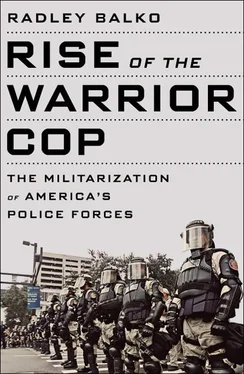Sims had been arrested under the Fugitive Slave Act, passed the year before as part of the Compromise of 1850, a package of bills aimed at ameliorating the growing tensions between free and slave states. An earlier Fugitive Slave Act, passed in 1793, already prohibited citizens from aiding the escape of slaves and mandated their return to their masters. But as slavery fell out of favor in the North, many cities and towns became places of refuge for freed slaves. State legislatures in the North began passing laws that made it easier for escaped slaves to win their freedom. The 1850 law was passed to plug the holes that had subsequently been poked in the law passed a half-century earlier.
Even for its time, it was an outrageous piece of legislation. 14Any black person in a free state could be claimed as an escaped slave on little more than the word of a Southerner claiming to own him. The accused would then be arrested and given a hearing (not a jury trial) in front of an appointed federal commissioner (not a judge). Denied habeas corpus, the alleged slave was neither permitted to testify on his own behalf nor allowed to personally challenge the word of the man who claimed him as his property. The commissioner’s decision could not be appealed. Anyone aiding a slave’s escape—even by merely offering him food or water—was guilty of a federal offense, punishable by a $1,000 fine and six months in prison. Not only were federal marshals paid bounties for capturing escaped slaves, they could be fined $1,000 if they refused to arrest a black person whom any white person claimed was a slave. As if all that weren’t enough, the appointed commissioners who decided the fates of the accused were paid $10 if they ruled in favor of the slave owner, but just $5 if they ruled in favor of the alleged slave. The law was so skewed toward slave owners that even blacks who had been free all their lives were at risk of being consigned to slavery by false accusations.
The Sims case attracted national attention among opponents of slavery. When Sims was ordered back to the plantation, prominent abolitionists like Frederick Douglass, Ralph Waldo Emerson, William Lloyd Garrison, and Henry David Thoreau wrote enraged polemics condemning the farcical proceedings, but most of Boston was complacent. The prospect of a civil war was daunting. For the time being, many in the North were willing to tolerate slave-catching as the price for avoiding bloodshed—at least blood shed by people other than slaves.
Three years later, the mood had changed, and Boston was again the site of a fugitive slave hearing. Nineteen-year-old Anthony Burns had escaped to Boston from an estate in Richmond, Virginia. 15He was working for a clothier when he was apprehended on May 24, 1854, by slave catcher Asa O. Butman, who arrested him under the pretext of a jewelry store robbery. 16On the morning of Burns’s hearing, armed abolitionists calling themselves the Vigilance Committee forced their way into the courtroom with a battering ram. In the ensuing melee, a federal marshal was killed. The rescue was unsuccessful, and the rescuers were arrested, but the event captured Boston’s attention—and the country’s.
When Burns’s hearing resumed the next day, thousands of people came out to protest. Boston mayor J.V.C. Smith called up two companies of the Massachusetts militia to keep order for the remainder of the hearing. Finding those forces inadequate, he then contacted President Franklin Pierce directly to request that two US Army battalions and fifty Marines be sent to Boston. 17
During his 1852 campaign, Pierce had vowed more robust enforcement of the Fugitive Slave Act. So when Smith asked for troops, Pierce consented. He also put hundreds more troops on standby just in case Smith needed them. 18By the end of the week, the hearing still wasn’t over. Because Burns would have to be kept in Boston over the weekend, the troops had to stay there too. The protests grew, as did tensions between the troops and the protesters.
On June 2, 1854, slave commissioner Edward G. Loring—a double cousin of the man who had defended Thomas Sims—ordered Anthony Burns returned to Virginia. Some fifty thousand Bostonians poured into the streets and took to rooftops in protest. 19Some flew American flags upside down, and others shouted “Kidnappers!” at the police and soldiers. One group hoisted a coffin under a banner that read, THE FUNERAL OF LIBERTY. 20The city was angry, as much at the law as at the amount of force their own state officials had brought to bear to enforce it.
The moment Loring issued his decision, Boston went into lock-down. The troops fired cannons in the air as a warning to the protesters. The mayor declared martial law (probably illegally). 21Over the next several hours, US soldiers and state militiamen cleared the streets of Boston. On several occasions, the militiamen fired into the crowd. When the troops mistook a crowd surge for an assault, they charged the protesters with bayonets. There were numerous injuries, a few of them serious, but somewhat miraculously, there were no fatalities. 22Once the streets were cleared, another group of troops marched the prisoner from the courthouse to the steamship waiting for him at the docks. From Boston Harbor, the site of the Boston Tea Party, the ship and the federal troops aboard it took Anthony Burns back to Virginia—from a city nicknamed “the Cradle of Liberty” to the shackles awaiting him in Richmond.
It hadn’t yet been one hundred years since the Boston Massacre, in which British soldiers fired first into the air, then directly into a mob of angry protesters, effectively sparking the American Revolution. Yet, on the morning of June 2, 1854, it was US soldiers who lined Boston’s streets, who fired shots from a cannon positioned in the town square as a warning to fellow Americans, and who used the threat of military force to silence the speech of American citizens. The reason for the protests—that a man who had escaped the yoke and found refuge in the arms of a free state was being sent back into bondage—only compounded the poignancy of the scene.
The heavy-handed response and the arresting imagery of federal troops imposing martial law on an American city was bad enough. But the Anthony Burns affair also brought about a new and significant breach of the Symbolic Third Amendment. Like Franklin Pierce, who had appointed him, US Attorney General Caleb Cushing was a doughface , a Northerner with Southern sympathies. He had been looking for an occasion to strengthen enforcement of the Fugitive Slave Act, as his boss had promised in the campaign. In response to the vigilantism and public backlash in Boston, he issued what became known as the Cushing Doctrine. 23The policy allowed US marshals to call up the military to help them enforce federal law, without explicit authorization from either the president or the Congress.
Prior to the Cushing Doctrine, when a US marshal needed a posse, he typically drew it from men in his jurisdiction. If he needed backing from the military, he had to get authorization from the president. The difficulty of obtaining that authorization made such requests rare. The Cushing Doctrine made it easier. Calling on federal troops to use force against American citizens had been reserved for insurrection or rebellion, but now there was a new criterion: a single marshal could call up troops merely if he felt that people were preventing him from performing his duties. The opinion would be used to hunt down fugitive slaves in northern states where the fugitive slave law was unpopular, to put down John Brown’s antislavery revolt at Harper’s Ferry, West Virginia, and to enforce federal law on the relatively lawless western frontier.
A major barrier had come down: the federal military could now be routinely used to enforce federal law. And it happened not by way of a constitutional amendment, or a vote from an elected Congress, or even a Supreme Court decision, but after an opinion issued by a US attorney general.
Читать дальше












